Acer Aspire S7 Ultrabook: Acer’s Best Foot Forward
by Jarred Walton on January 7, 2013 4:30 AM EST- Posted in
- Laptops
- Acer
- Intel
- Ivy Bridge
- Aspire S7
- Ultraportable
- Ultrabook
Performance, Now with Windows 8
As this is the first laptop we're testing with Windows 8, we've had to go back and revamp our testing suite a little bit. For example, PCMark Vantage simply refuses to complete under Windows 8 on the S7, and the same goes for a few other old Futuremark programs; we'll add the next versions of PCMark and 3DMark when they become available, but PCMark 7 and 3DMark 06 and 11 are the only Futuremark tests we’ll be running for now.
We're also taking the opportunity to upgrade several of our older benchmarks; we've been using the x264 HD 2.x encoding benchmark for a while now, but we're going to upgrade to 5.x with Windows 8—which, incidentally, takes about 10x as long to run. We will also be adding WinZip as a benchmark, with OpenCL acceleration enabled. Another benchmark we're adding with the S7 is TouchXPRT (currently in preview release) and a similar test from the same company called WebXPRT 2013. Anand has used both on the Clover Trail/Surface reviews, so it will be interesting to see what Ivy Bridge looks like by comparison. I’m not going to spend a lot of time on the tablet comparisons in terms of performance, but I also ran most of the current suite of tablet benchmarks, which we’ll look at on the next page (SunSpider, Kraken, etc.)
For the time being, that should be sufficient, but we'll be certain to add other benchmarks and tests to the mix as we deem them appropriate, so if you have any recommendations or suggestions we're happy to hear them. We will begin as usual with PCMark 7, which gives us at least some inkling of overall performance, along with our usual suite of CPU-centric tests. We shouldn't see any major surprises here, as the Acer S7 has the same components as many other Ultrabooks that we've tested. Here’s the quick overview of the test components for the various laptops:
| Laptop Configuration Overview | ||||
| Laptop | CPU | Graphics | Storage | Battery |
| Acer Aspire S3-951-6432 | Intel i7-2637M | HD3000 | 256GB SSD | 38Wh |
| Acer Aspire S5-391-9860 | Intel i7-3517U | HD4000 | 2x128GB SSD | 35Wh |
| Acer Aspire S7-391-9886 | Intel i7-3517U | HD4000 | 2x128GB SSD | 35Wh |
| Apple MacBook Air 13 (Mid-2012) | Intel i5-3427U | HD4000 | 256GB SSD | 50Wh |
| ASUS Zenbook Prime UX31A-DB71 | Intel i7-3517U | HD4000 | 256GB SSD | 50Wh |
| Dell XPS 13 | Intel i7-2637M | HD3000 | 256GB SSD | 47Wh |
| HP Envy 14 Spectre | Intel i7-3667U | HD4000 | 2x128GB SSDs | 56Wh |
| HP Folio 13 | Intel i5-2467M | HD3000 | 128GB SSD | 60Wh |
| Intel IVB Ultrabook Prototype | Intel i5-3427U | HD4000 | 240GB SSD | 47Wh |
| Toshiba Satellite U845-S406 | Intel i5-3317U | HD4000 | 500+32GB Hybrid | 54Wh |
| Toshiba Satellite U845W-S410 | Intel i5-3317U | HD4000 | 500+32GB Hybrid | 54Wh |
Before we get to the actual tests, I want to make note of the fact that this is bar none the fastest booting laptop or PC that I've ever used! Just how fast does the laptop boot up? How about under 10 seconds? Granted, much of that is probably Windows 8 (Dell’s XPS 12 posts similar boot times), but it's still impressive nonetheless. Shutdown, hibernate, and resume are all equally fast, though if all you do is put the laptop to sleep and wake it up you won’t need to worry too much about such things.
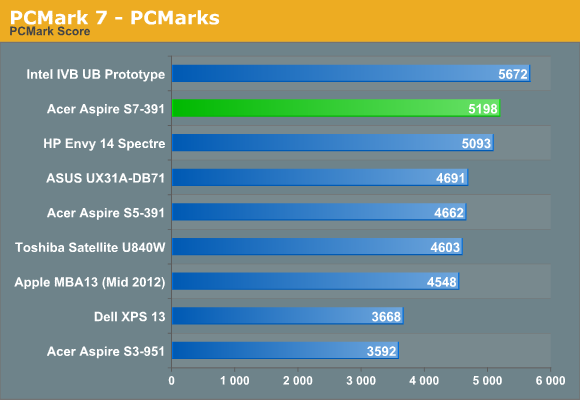
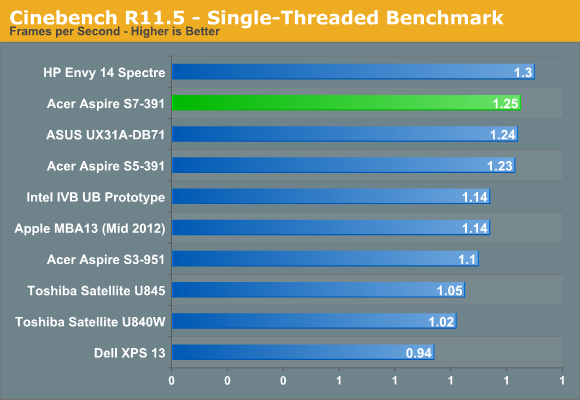
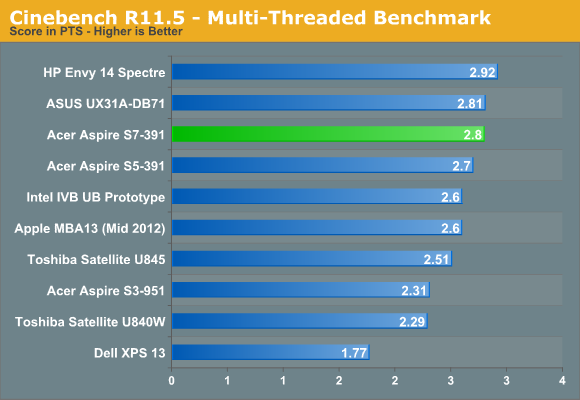
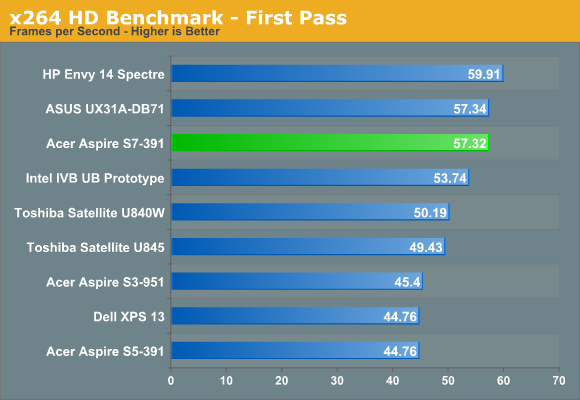


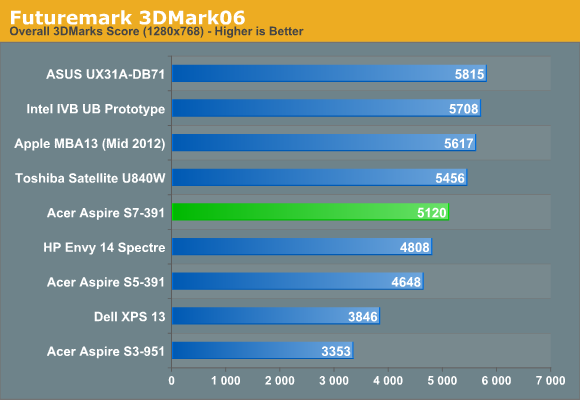
Our benchmarks start with an interesting piece of information: the Ivy Bridge prototype that Intel sent us still manages to hold onto the top spot in the overall PCMark 7 score, thanks in particular to its performance in the Creativity, Entertainment, and Computation suites—and this despite the fact that it’s equipped with a Core i5-3427U compared to the i7-3517U in other systems. (We only show the overall score above, but you can see the full set of PCMark7 results in Mobile Bench.)
It’s not quite clear what’s holding the S7 back, but while it has the top Storage score, it falls well short in the Lightweight and Productivity suites. Possibly Windows 8 is partly to blame, or more likely the combination of components (and possibly that RAID 0 storage setup) are coming into play. Then again, PCMark7 is prone to odd variations, and depending on the drivers (Quick Sync) and storage you can see large differences between what should otherwise be similar laptops—just look at how the earlier Aspire S5 with Windows 7 stacks up to the new Aspire S7!
The other benchmark charts are more in line with what we’d expect. HP’s Envy 14 Spectre snags the top spot for all of the CPU benchmarks, which makes sense considering it has the highest clocked i7-3667U processor of the bunch. The Acer S7 and ASUS UX31A are tied, which goes with their identical CPUs. 3DMark06 does show the Acer falling behind, but here again I’d look more at Windows 8 than anything specific to the S7. The march of time and/or drivers also shows a nice progression when looking at the S3, S5, and S7










53 Comments
View All Comments
rarson - Thursday, January 10, 2013 - link
First of all, it depends on the type of accident. I can guarantee you that a head-on collision with a wall at, say, 30 mph will be safer in a Smart Car than an Oldsmobrick.The fact of the matter is that when it comes to protecting the passenger, crumple zones and safety cages are more important than mass. Today's cars are designed to absorb the energy of the crash, to soften the impact on the passenger. Older cars were designed with the mentality that if the car survived mostly unscathed, then the passenger would as well, which is obviously incorrect. If safety is your primary concern, then you're better off looking at crash testing than vehicle size or weight. But the absolute best way to increase your safety is to become a better driver.
Tech-Curious - Thursday, January 10, 2013 - link
It's a matter of mass and size. Your guarantee is preposterous, because a Smart Car has precious little space within which to crumple, without also crumpling the people inside of it. The size of the wheelbase, the cabin, and yes, the mass of the vehicle are all important.
I've been in a head-on collision in a compact car with a much heavier object (a semi-truck). Trust me when I say that I'm lucky to be alive; if I hadn't swerved at the last second, I would have been vaporized, because the truck literally drove through the right side of my engine compartment, and didn't come to rest until its front bumper was sitting on my passenger seat.
Thank god no one was sitting there. The truck's damage? A cracked headlight.
Now, if I had been involved in the same accident in an Oldsmobrick, as you call it, the car would much more likely have kept something approaching its original shape. A passenger or I could have died from the internal trauma caused by the savage stop; that's true -- but the passenger would have died in more-or-less one piece.
Let's not kid ourselves: The Smart Car is little more than a roofed motorcycle, for all the protection it offers your body. Many modern cars are safer than their (often heavier) ancestors, but I chose the Smart Car because it represents an extreme, and I thought (erroneously, as it happens) that the extreme example would illustrate the point without courting controversy.
And yes, good driving habits comprise the best safety measure available -- but it's a mistake to assume that you're ever 100% in control of any situation on the road. The essence of safe driving is to understand that you don't have that control, to minimize your risk by putting yourself into the best position to react to sudden hazards. Even so, not all hazards are avoidable.
Tech-Curious - Thursday, January 10, 2013 - link
Oh, and with regard to crash testing, you have to be very careful. Tested safety ratings might rule out weight and size: for instance, the Smart Car recently got a safety rating similar to the Trailblazer's -- but you'd have to be out of your mind to conclude that both vehicles are equally safe.The Trailblazer is simply at the same level, relative to its analogues, as a Smart Car. A couple of statements from (or paraphrases of) the president of the Insurance Institute from Highway Safety follow:
(From http://www.msnbc.msn.com/id/24599768/ns/business-a...
(from http://usatoday30.usatoday.com/money/autos/2009-04...
(from http://usatoday30.usatoday.com/money/autos/2009-04...
And finally, the tale in pictures. Trailblazer: http://media.caranddriver.com/images/media/191279/...
Smart Car: http://node1.ecogeek-cdn.net/ecogeek/images/storie...
rarson - Thursday, January 10, 2013 - link
"Once you get to the point where the price isn't as much of an issue (especially for something you'll be using for 4-5 years) the enjoyment of using something that has high-quality interface points (monitor, keyboard, etc.) quickly overcomes the cost difference."In that case, the Acer (and the Macbook Air) fail completely. I've got a $350 Trinity laptop that I'm using right now that has a much better keyboard than both of these, and even my old PII Compaq laptop is DRASTICALLY better. I understand what you're saying about touchpads (the laptop I'm using definitely has some quirks that can make the touchpad frustrating), but I find it laughable when people call these devices "high quality" when they have such terrible keyboards.
rarson - Thursday, January 10, 2013 - link
1) Uh, every device that I've tried feels fragile in my hands due to the actual thickness, not the construction or materials. That's why I said I "feel" like I'm going to break the thing.2) Well that's just absurd. Anyone can easily see the value of a Mercedes. You can't tell the difference between a car with solid body construction and quality sound deadening? It's a pretty marked difference between, say, a typical economy car. You don't seem to understand the difference between seeing the value and actually desiring it.
There's no exceptional build quality here. The device isn't going to last longer or significantly outperform a comparably equipped, but much cheaper laptop. All you're getting is a decent display (with the added cost of touch), a slimmer chassis, and an unjustifiably higher price. So where exactly is the value proposition here?
The0ne - Monday, January 7, 2013 - link
This is an Ultrabook laptop. These are usually not cheap to begin with because they are Ultrabooks. Why are people comparing these to notebooks that are not even in the same class? These are not even in the same class as business notebooks as well. Subjectively, these are expensive because they are light and thin. Most of the readers here won't even consider buying one to be honest or may have never own an ultrabook before. The market for these are business travelers where they need the light weight and thinness to carry it around for long periods of time.I just don't understand why people would complain about something that they don't begin to comprehend what it is and what market it is aimed at.
rarson - Thursday, January 10, 2013 - link
You're right, I don't comprehend what market these are aimed at, since a regular laptop is only about a pound heavier than this thing, and might actually offer a decent keyboard and slightly larger screen real estate, things that I'm pretty sure would be far more important to the average businessman than "thin and light," at a significantly lower price, no less.Perhaps you could explain to me why a businessman would need a touchscreen on a laptop, or 1080p resolution in a 13" screen.
You said it above: "These are usually not cheap to begin with because they are Ultrabooks." Right, they are'nt cheap because they're marketed as expensive devices. I'm sure it costs more money to make the thinner, lighter chassis. But that doesn't mean that it makes sense to pay more for it.
jabber - Monday, January 7, 2013 - link
.....did we get a indication of what this machine is like out of the box?In other words -
1. How long did it take from first switch on till actually being able to use it properly?
2. How much crapware was installed and how long did it take to uninstall?
I have known Acer laptops (and others from similar companies) to take a couple of hours messing around till you can actually use them. I love the ones that force you to burn a set of recovery disks at start up and threaten thats its a once in a lifetime deal.
bobjones32 - Thursday, January 10, 2013 - link
I posted elsewhere in this thread with my impressions, but my wife purchased this from a Microsoft Store. That means it comes with a Signature image, so no bloatware, and ready to use straight out of the box.The thing turned on instantly, set up quickly, and she was using it fully within just a few minutes.
thesavvymage - Tuesday, January 8, 2013 - link
I seriously do not understand on having the "thinnest" laptop you can have. You dont hold it in your hands, it sits on your lap. The screen size and overall volume are what matters the most (for bulk). This laptop is .5" thick. If they even increased it to .7", they couldve added a bigger batter and better cooling, and it wouldnt even seem that different to anyone without a milimeter caliper.